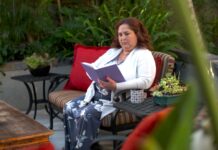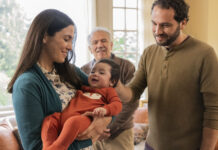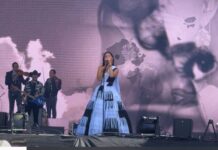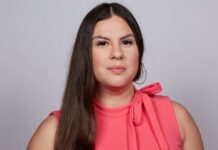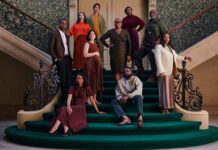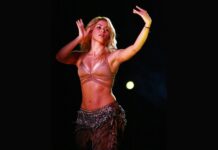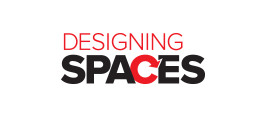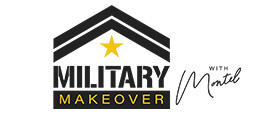Bravery comes in different shades. These shades vibrantly paint the world, making our time here that much more worthwhile. It can become present in anyone and can manifest itself in the most mundane instances. Regardless of the situation that arises, if you’re adding an extra inkling of hope to this world that may sometimes feel a bit bleak, it will have plenty of value. This is something Lyla June seems to understand.
June is a Native American with Diné and Cheyenne lineage. She is an anthropologist, politician, public speaker, musician, educator, and overall a dedicated social justice warrior. Aside from those skills, she’s also currently pursuing her PhD in Indigenous Studies from the University of Alaska Fairbanks.
One of her most recent projects involved a foray into the political world. June decided to run for New Mexico State Representative in District 47 a few months ago. Her campaign emphasized pressing issues such as climate change, Indigenous health, and anti-corruption, among other objectives. Though the seat was not succeeded by Lyla June, her unwavering courage didn’t go unnoticed.
She fasted, fought for all youth, and let her Native American roots shine in a stage seldom known for its inclusivity. June is someone that pushes through, despite the obstacles in front of her. Proof of this is when she fought to try to stop the pipeline from being constructed through Standing Rock. She’s passionate and is not afraid to let it be known.
BELatina News recently had a conversation with Lyla June to get to know her a bit better. This is what she had to say about her ongoing goals and her tireless determination:
First of all, congratulations on running for office. It takes guts to do that. Now that you’ve gone through the process, what are your thoughts on your political experience?
I always knew politics was dirty, but I didn’t realize how dirty it was. However, I had a great time bringing my ideas to people and inspiring the public. We were rolling really fast, but you know, that’s why the oil and gas lobby and establishment came down on me so hard. I was a true threat to their establishment. To be frank, it ended in a very ugly way and I had to make a decision whether it was worth my time, resources, and energy, to defend myself against a machine or redirect all of my free sources to something more fruitful. We ended up transforming the campaign from a single candidacy to working to the Youth United for Climate Crisis Action (YUCCA). We are now using our money and network to build a voter’s guide to help all voters across the state. I’m going to stand behind the youth because it seems to be more fruitful that way. Nonetheless, I know that I gained a lot of lessons and experiences from young people of color running for office. Even though I didn’t pierce through the walls of power, I know that people can learn from my experiences and I can leverage that to help our people get into those positions of decision-making.
I saw that you fasted seven days during your political campaign. Do you suggest others to do this as well?
I would definitely promote fasting as a way to bring attention to certain issues for a lot of reasons. Number one, it’s nonviolent in nature, so you can get your point across in a way that really demonstrates your integrity. Secondly, it helps develop your own connection to yourself and to the issue on a personal level between you and your spirit. Thirdly, it really proves to people that you are who you say you are and that you’re there for the right reasons. There’s no way someone would stop eating if they were just there for the money or fame.
I fasted for seven days on the capitol steps in Santa Fe, New Mexico during my political campaign. I did seven days because I wanted to pray for the next seven generations to come. We, Native Americans, talk about how we must consider the effect on the next seven generations to come with every action we take. What I found is that on the second day, I felt like I was going crazy. On the third day, I felt crazier. However, on the fourth day I broke through some kind of wall and I felt so strong and clear. More clear than I had ever felt before. My mind, heart, and spirit were all connected. I thought I would be really out of it by the seventh day, but I was actually sharper and clearer than all the other days prior. It’s a very precious experience. It really helps you hone in on your own thoughts about a certain issue.
But yes, I would definitely recommend this — you just have to do it very carefully. You have to do it in a safe space. I found that fasting on the capitol steps was not a safe space. There was a lot of chaos around me. So, I would make sure you have a lot of support and you have a space to do it. Take care of yourself and make sure nothing can get at you or distract you while you’re on this journey.
Also, I read that you’re organizing a ‘listening tour.. What does that mean exactly?
The listening tour is all about generating policy from the bottom up. A lot of times, the policies that affect everyone’s lives aren’t even created by the community. So, I think it’s very important to hear the voices of communities across New Mexico and what they think would be good to do for the climate crisis. Also, to allow them to have a say in how we move forward. Essentially, we go community to community and we ask them, “What do you view the solution to climate change being?” and they come up with amazing ideas, beautiful ideas that we have created together. We are going to synthesize all of that to create a Seven Generations New Deal 2.0.
We want the second draft of the Seven Generations New Deal to be informed by the community. What I found is that a lot of leaders think that they can create choices better than the people. If they do involve the people, they think they’re just doing a favor to the community. What they don’t realize is that if they involve the community, they’re doing a favor to themselves. They’re doing a favor to the policy. When you bring in the ideas of the whole community it is a million times better than anything we can come up with alone. Maybe they don’t have a college degree or a PhD, but the people are brilliant. If you trust in them and have faith in them, you will be pleasantly surprised at how beautiful of a tapestry the community can weave together if they put their heads together.
I think what we need to confront is the climate crisis and I think the coronavirus is really highlighting that. What would we do if all of a sudden everything needed to be localized? What would we do if everything we needed we had to get by walking? The climate crisis is requiring us to transform our entire society on every level. The only way that we can transform our society is to have the fabric of society involved in the creation of these solutions. If the whole of society creates, then we can influence society on a deeper level.
It seems as though you’re always trying to do things with a purpose. So, I must ask: What’s your main purpose at the moment?
My biggest passion right now is my PhD and my climate work. My PhD is an effort to revitalize Indigenous food systems and indigenous land management. In Mexico, South, Central, and North America, we have really advanced food systems. For instance, in Lake Texcoco and Tenochtitlan they had chinampas. Truly, my main goal is to uplift Native Americans and Indigenous food systems to prove that we are not savage or uncivilized. Our ancient societies and civilizations were actually incredibly advanced and sophisticated.
I’ve traveled around to many places looking at the Indigenous food systems and I’ve recorded what I’ve seen. Using that information, I’m going to be implementing a curriculum to teach Native American children how to create food on a local scale and to use Indigenous techniques to do that. I just want to show that the history that people write about Native Americans is completely inaccurate. They say we are half-naked nomads, running around the forest, but the truth is that we had vast societies and we populated the land densely, as well as managed the land extensively. We had organized communities.
For instance, the Heiltsuk Nation that I visited recently in Canada, they press kelp by hand. This kelp garden creates more surface area for the herring fish to lay their eggs. When the herring come and lay their eggs or roe, they just completely cover the entire shoreline. That feeds the salmon, the killer whales, the wolves, the entire food web. So, Native Americans — or First Nations how they’re called in Canada — are actually supporting an entire food web by planting this kelp. And that’s part of their job — to make sure that their land is healthy. They’re so good to the earth that if you take these people away from the land, the land will suffer. I’m trying to write my PhD in a way that both recharacterizes Indigenous people as food scientists, food experts, and also generate a mechanism through which we can bring this knowledge to the youth.
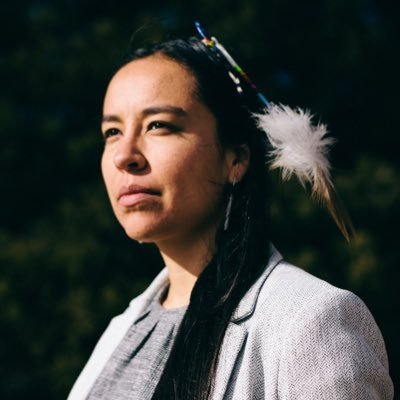
How do you maintain your determination and commitment to your vision?
Well, you have to understand that I am a former drug addict. I started to do drugs when I was 11. I’m also a survivor of child abuse — of child sexual abuse. When I was 20, I had nothing. I literally had nothing. I was so addicted to drugs and alcohol. Sure, I was going to Stanford University at the time, one of the best schools in the country, but inside of my spirit I was broken and lost. So, when my Native American elders picked me up out of that place, gave me a ceremony, and helped me heal, I felt like I had a reason to live. Before, I didn’t have a reason to live. I hated myself; I thought the abuse was my fault. I thought I was ugly, disgusting, and tainted. I didn’t care about anything but to do drugs. However, when my elders found me, they taught me how to be a healer and how to be a positive force in the world. They also taught me how to serve the Creator, how to fight for the Creator, how to live for the people, how to pray for the people, and how to live your life as a prayer. All of sudden, I understood why I was here.
Now that I have a reason to live, I know that I’m beautiful, sacred, and powerful. I also don’t care how bad things get, the whole world can be falling apart, but I would still be trying to serve the people. Another thing, my ancestors lived in a time where viruses were wiping out our entire villages. Ninety-eight percent of Native Americans were annihilated in the process of colonization and we are still being annihilated. Imagine my ancestors 300 years ago and their entire world is getting destroyed all around them. Their food, language, land, everything they knew was being destroyed. But did they give up? No. They kept going forward and trying to help people around them.
It’s not about whether the situation is hopeless or hopeful. That doesn’t determine whether or not you get up in the morning and try. Even if it’s completely hopeless around you, you have to get up and try. That little bit of trying might make a difference and that makes it all the worthwhile.
How do you keep your optimism in a world that is often filled with cynicism?
My elders told me that victory is not always a physical victory, but it’s a spiritual victory. For instance, at Standing Rock when we were fighting the pipeline. The pipeline did go through, it was put in the ground, but we still won because we fought in a good way. We never lifted a weapon, we never hurt anyone, we always fought with a prayer on our lips. We brought people together from across the world. We raised consciousness about the sacredness of water and every person who came to our camp was healed and transformed. You have to redefine victory in this time to remember that victory happens through the process, not through the outcome.
Being that you’re so knowledgeable about Indigenous people, do you feel there’s a link in the Indigeneous groups of North America and Latin America?
We are the same people. We share the same creation stories. My people have a creation story about the twins and some of the Maya groups have creation stories with the twins. The only thing that separates us is an imaginary colonial border. We have to take away the borders of our minds as Indigenous people and remember that we are all one. We are all related. Our ancestors used to have kinship routes and trade routes all the way from Alaska to Patagonia and all the way from Canada to Central America. We had communication. In New Mexico, a lot of the tribes have historically needed parrot feathers for our ceremonies. You can’t do some of our ceremonies without parrot feathers. However, there’s no parrots in New Mexico. So, where did we get the feathers? Well, we got them from our relatives in the South.
It’s hard because in what we now call “America,” there was an American-Indian movement in the 1960s and for us it became very cool to be Native American. But a lot of places in Mexico, Central, and South American, didn’t have this kind of movement, making it not always “cool” to be Native in the South. In fact, some people in the South perceive it as an insult. I know some say, “Le salio el indio,” and that is a bad thing to them. To us, it’s a good thing, like, “Let the indio out of you!” Express it, sing it, dance it, be it. That should be a compliment, not an insult.
Or some people say, “Hay que mejorar la raza.” In other words, marry someone more white, so that you can give your children whiter skin. We don’t have that here in America anymore, but we used to. Well, some places still think that way, but now people are starting to want to marry brown-skinned people. Sadly, it’s hard to find Native people anymore. We are disappearing. There is also the fact of how children who are whiter are the preferred child. This happens often in Mexico. That needs to stop. We need to have pride in who we are. We need to have pride in our Indigenous ancestors because we are being fooled by the Eurocentric definitions of beauty. Indigenous people are being tricked that they are superior, but they are not. We are equal.
So, my job as a Native American is to honor, respect, and acknowledge the Indigenous identity of Latinx people. I see you, I honor you, and you and I are the same people.
Any final words for the readers?
Love yourself. Always love yourself and see the beauty of your ancestors. Don’t fall for the tricks that capitalism and eurocentrism have tried to put on our people. Know the beauty of the roots that you come from and know that Indigenous societies were far more advanced than they tell us. Know yourself and to know that is medicine. You carry the medicine of your ancestors. It’s time to honor the Indigenous and feminine spirit across the planet.
For Image credit or remove please email for immediate removal - info@belatina.com


